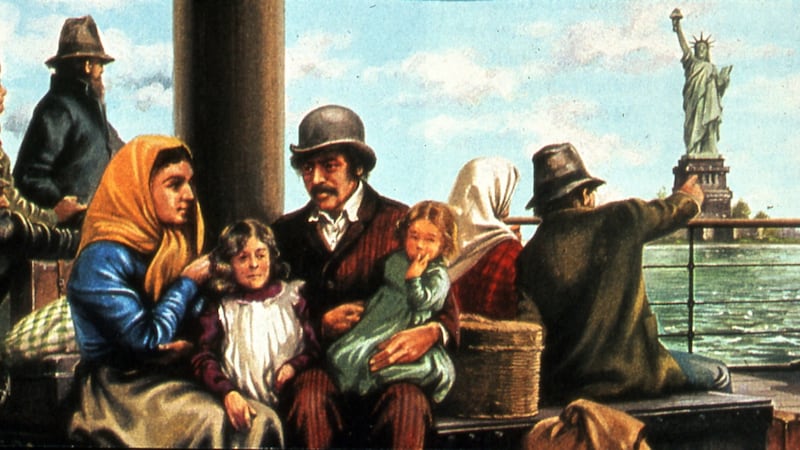President Donald Trump’s determination to deport undocumented immigrants has drawn criticism not only from his opponents within the United States but also from the international community. As suggested by Taoiseach Enda Kenny’s reference to the estimated 50,000 undocumented Irish immigrants during his recent meeting with the US president, American immigration policy is deeply related to people of Irish descent.
And the connection between American immigration policy and the Irish is not a new one. As I have demonstrated in my recent article, the Irish were in fact the first targets of deportation policy in the United States. In the nineteenth century, Atlantic seaboard states, especially Massachusetts, systematically deported indigent Irish immigrants back to Ireland and Britain. Here are the experiences of some Irish deportees.
Mary Williams gave birth to Bridget in Massachusetts, shortly after landing in New York in 1855. Becoming destitute, the mother and the daughter entered a public almshouse in Massachusetts. In May of the year, discovering Mary's Irish-born status, Massachusetts officials forcibly sent her to Liverpool with Bridget, who was a native-born US citizen. This deportation was doubly illegal. While Massachusetts law limited overseas banishment to noncitizens, it required the officials to obtain a court warrant for removal. Massachusetts officials almost kidnapped Mary and Bridget Williams from the almshouse without such warrant and shipped them away.
Some deportees experienced "double deportation." In 1855, Massachusetts officials deported to Liverpool eight female Irish paupers with mental illness. Liverpool authorities put them on board a ship to Dublin
Ann Gray, a native of Co Galway, emigrated to the United States in 1860. In 1867 she developed insanity and entered a Massachusetts almshouse. Gray's two-year residence at the institution did not cure her insanity, and Massachusetts officials decided to deport her to Ireland in the spring of 1869, with three other lunatic Irish women – Abbey Butler, Mary Cullen and Esther Daly. In April, the officials sent them to New York, where they took a ship to Cork. Upon arrival in the port of Queenstown in Cork, Massachusetts immigration officials ruthlessly dumped the women on the street without any provisions for self-support, such as money, food, or clothes - a routine practice of the officials. The women roamed helplessly until a local officer of Cork accidentally found them.

Some deportees experienced what might be called "double deportation." In late January 1855, Massachusetts officials deported to Liverpool eight female Irish paupers with mental illness. Upon finding the lunatic women among arriving passengers, Liverpool authorities put them on board a ship to Dublin under the British poor law, which allowed for the removal of Irish paupers in Britain to Ireland. Five of the deportees – Anne Arbuthnot, Mary Shiel, Hannah Irvine, Anne Taggart and Mary Sheeby – were found by a Dublin official "wandering about the quay, not knowing what to do or where to go," and taken to the North Union Dublin Workhouse. Being banished first from the United States and then from Britain, the Irish migrant poor were indeed stateless people.
John McCarthy had emigrated from the town of Tralee to America and naturalised to become a US citizen. During the American Civil War, he enlisted in the Union army. After the war, he suffered from poor health and returned to Ireland. In late May 1883, McCarthy and his wife received assistance from Tralee poor-law officials to emigrate to New York. A few weeks after landing, McCarthy and his wife lost all their money and applied for relief from New York's immigration officials. They told the couple that the wife, who was then blind, should go back to Ireland. McCarthy tried to claim public relief for himself and his wife on the basis of his American citizenship. But the New York officials ultimately sent both of them back to Ireland, viewing them as unwanted burdens on American society.
The expulsion of the Irish in the nineteenth century laid the foundations for many of the central features of contemporary American deportation policy
The expulsion of the Irish in the nineteenth century laid the foundations for many of the central features of contemporary American deportation policy, such as the uncivil manners and illegality of removal, the disregard for deportees' basic welfare and the rights of their citizen family members, and the notion that deportees never belong to the United States. If American deportation policy matters to the Irish, that is not only because of undocumented Irish immigrants in America today but also because of the fact that the policy fundamentally originated from anti-Irish nativism, especially economic antipathy to the poverty of the Irish.
Hidetaka Hirota teaches American history at the City University of New York-City College. The stories in this article are taken from his recent publication, Expelling the Poor: Atlantic Seaboard States and the Nineteenth-Century Origins of American Immigration Policy (Oxford University Press, 2017)

















